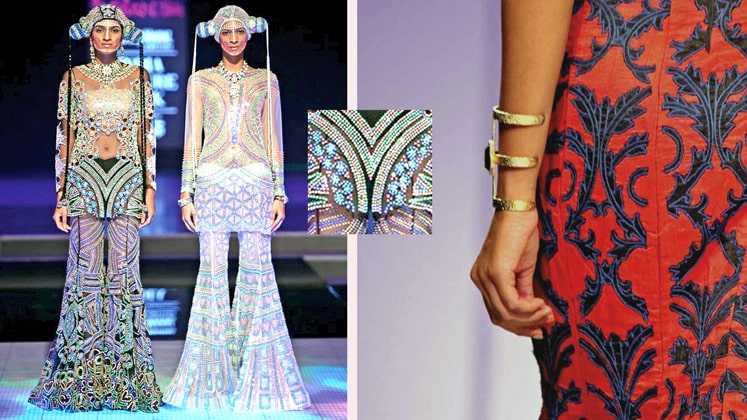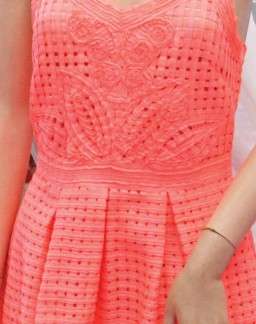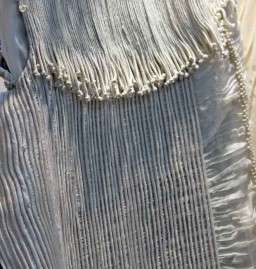
With growing popularity and application of hand-done techniques amongst Indian and International designers, exporters have been attempting to offer parallel designs and techniques in the mass market as well. But owing to the high production and value addition cost involved in this process, exporters are tweaking the handmade techniques to suit the price and design requirements of the export as well as domestic buyers. Supporting exporters in this endeavour, are machine manufacturers who have introduced a range of machineries which not only mimic techniques, be it hand embroidered bullion knots, print looking intricate appliqué or obscurely laid cords and piping, to the closest possible variant but also translate them into commercially viable pieces.
eing known for its rich tradition of hand embroidery and fabric manipulation techniques, India has been able to inspire designers to offer colourful varieties. Year on year, designers not only keep on launching hand based collections with a crafted touch, but they also continue to impart newness into the age-old techniques to popularize Indian strengths. With consumers showing a lot of interest in adding designer labels into their daily wardrobes amid a restricted point of purchase, exporters seek opportunity in this scenario and adapt the hand-crafted designs into machine made. Though the point that can be argued upon here, is that the handmade and designer techniques have their own charm and beauty and machinery can never replace them, but with state-of-the-art machines offered by technology providers like HCA, IIGM, Lasser Swiss Embroidery Machines and others, which can give appealing results, automation of value addition is the growing trend of tomorrow.
Cord Work

Drawing inspiration from the Raag Bhinha Shadja of Hindustaani Classical music, Vaishali S took the viewer on a pensive and wistful journey with her A/W’14 collection. Elaborating on her collection, she said, “Moving ahead from the basic fabric manipulation techniques like gathering, pleating and pintucks, we have created an exquisite amalgamation of cord embroidery and piping. We have tried to create multi-layers of cording through hand stitching and turpai. The garments are garnished with textured cord embroidered rhombus booties and acanthus motifs entirely made out of cords.”
Now to make this complex cording a commercially viable technique, HCA offers a range of attachments and machines. “We are offering various different combinations in machines, but multipurpose machines are only suitable for people who do not need high production. We also provide dori making and pintucking presser foots with 3 to 4 inlays to facilitate multiple dori application at once,” says Anil Anand, MD, HCA.
Another designer, Rimzim Dadu, created breathtaking 3D textures with twisted chiffon cords and attached the cords of different sizes in distinct patterns. The chiffon chords were stitched from the middle and placed as jackets and pallus in saris. Sandeep Chopra, Owner, Kadambari International, exporter of readymade garments, talking about how the same can be duplicated through fringing said, “Synthetic rayon or viscose yarns and cords are braided together to achieve the similar effects. Another interpretation can be created while weaving as well, when the warp yarns can be left loose for a distance of 4-5 inches before another round of weft yarns is inserted.”
Matting

Taking inspiration from the mat making technique from villages, Nida Mehmood developed a new innovative technique of manipulating fabric called matting. In this technique she interlaced fabric stripes in a plain weave in such a way that after interlacing all the stripes, they together create imagery in unison. The resultant fabric looks a lot like a mat, created with bamboo stripes in rural areas. Mimicking a similar effect through usage of machinery, Sanjay, Director, Rekognation, has created dresses entirely made out of tapes. The company creates these dresses on specialized machines which interlace tapes in multi-directional way to create a look similar to matting. Sanjay explaining further said, “We have specially designed a machine in-house to achieve different and unique value additions. There are multi-head machines available in the market, but I have got the machinery changed, and replaced the existing embroidery heads with 6 different heads giving me 6 different outputs. Therefore, you can get all the 6-techniques done simultaneous on the same garment in different patterns.”
Print Trompe l’oile
Charu Parasher, in her A/W’14 collection created sheer bodices, fitted toggle coats resplendent in rich silken attire and “resham” patch work and appliqué. The intricate appliqué with leaf and floral motives, highlighted with thread and sequin embroidery projects, the look of embossed or printed brocade fabric. Mahavir Kankariya, Director, Kankariya Textile Industries, discussing about achieving raised effect through rotary printing and digital printing says, “In rotary we are able to generate embossed, foam, burnout and foil prints. We are generating prints which create a trompe l’oile effect and look like brocades or jacquards”.
Tribal Embroidery and Sequencing
Staying true to his fascination of neon brights, metallic tints and elaborate headgears, Manish Arora’s tribal brides showcased a balance of psychedelia and femininity in his India Couture Week 2014 collection. Getting inspired from multiple sources, like the Bulgarian bride, the Peacock Room in Castello di Sammezzano in Italy’s Tuscany region, the Japanese Tamari craft and the majestic crowns worn by historic monarchs, the designer presented garments with iridescent multi-colour stripes, gold rexine embroideries and 3D highlighted sequins.
Machine manufacturers like Krishna Engineers and ESC are offering their Hot Spangle fixing punching machine and DESOS spangle setting machine respectively, to cut down on the time put in, into hand stitching these stones.The machinery provides a massive production speed of 800 spangles per minute and can stick multi-colour spangles and sequins with much ease .
Pleat, please!
With packed together pleats in saris and kaftans, Kiran Uttam Ghosh, presented to the world a new innovative technique of pleating through her A/W’14 collection. Using organza as a material, Kiran created a range of manipulated fabrics by pinched and stitching the fabric in leheria technique which resulted into compactly created pleats. The similar effect, though not so compact, can be created with heat setting machinery on poly fabrics. A range of machine manufactures like Confident Engineering India Private Limited, Pack Pack India Private Limited and Keenmark Inc. have installed a range of heat setting machines in export houses to complete the need of the market for such effect.

Post a Comment